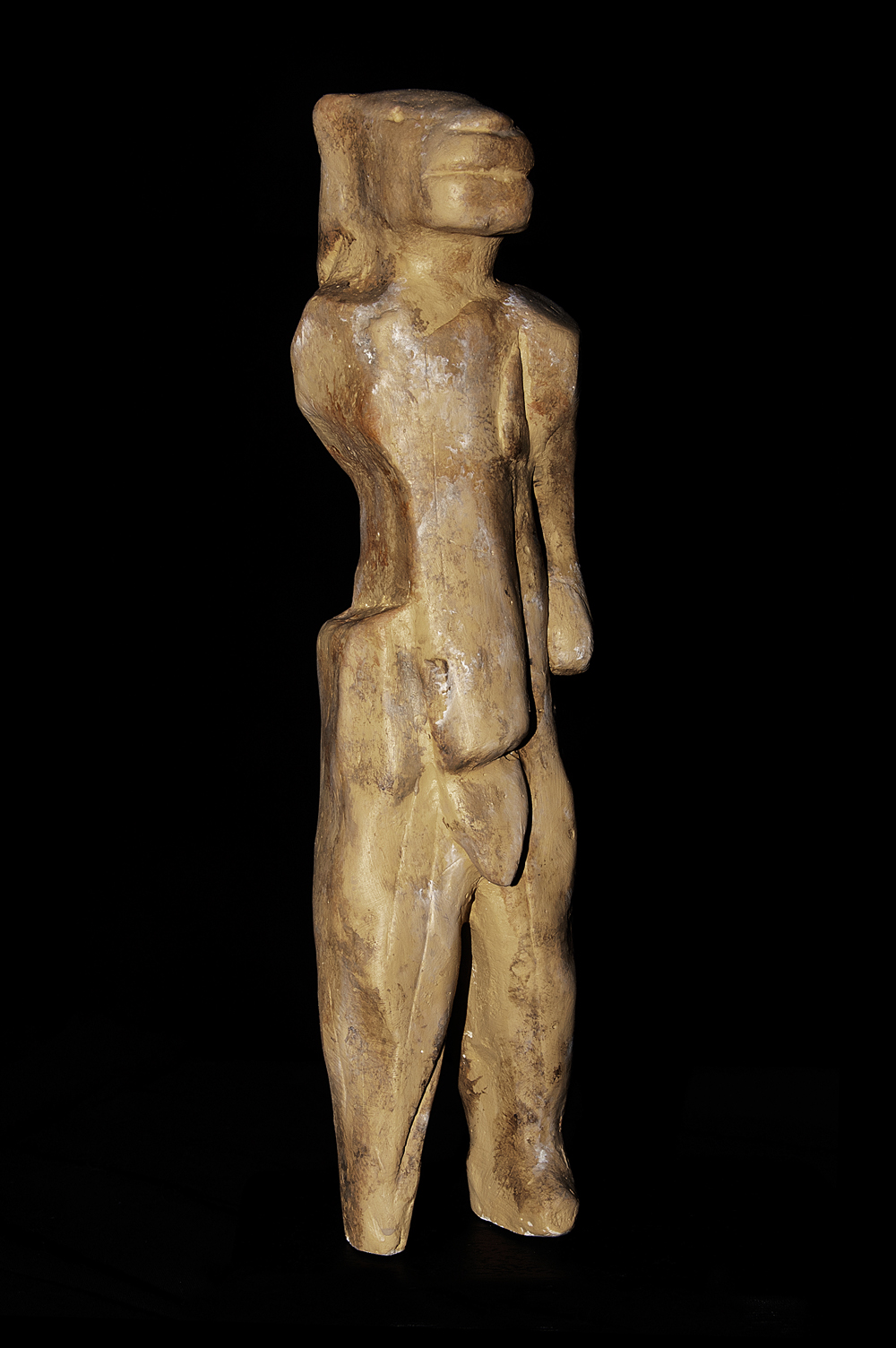


The Lion Man sculpture from the Stadel Cave, carved out of mammoth ivory, is now believed to be 40,000 years old based on carbon dating material from the same layer in which the sculpture was found. From the Aurignacian culture, it was carved using a flint knives, burins and scrapers.

Given its age, this is one of the earliest examples of the ability of the human mind to imagine things that do not actually exist. Dr Jill Cook, Deputy Keeper in the Department of Prehistory & Europe in the British Museum, in her publication 'Ice Age Art: Arrival of the Modern Mind', describes this as the activity of a 'super brain'; what might have been 'an arcane archaeological discovery has in fact become a talking point for the field of neuroscience.'
The original artist was highly skilled, and familiar with the stucture of the mammoth tusk. The form of the sculpture was conceived to make the best use of the characteristics of the ivory, such as the curve and the inner pulp cavity between the legs. It is estimated that the sculpture would have taken some 400 hours to carve, in other words, about 6 weeks. This is a considerable length of time to designate to art - not that it was merely art for arts sake - for a hunter-gatherer society, and therefore it was a very meaningful object.
It was found in many pieces - over 200 fragments - and parts of the front of the body are missing. The stance and muscularity of the shoulders suggest a man standing on tip toes with arms to his sides. The left upper arm is marked with incisions which might represent tattoos or scarring. The leonine head faces forward in an alert stare emphasised by a powerful jaw line and upright ears. Does the sculpture represent a deity? Is it a man wearing a lion headdress? Is it a mythical or supernatural being? The Lion Man was made as an avatar of particular symbolic and social messages, messages that we can no longer read.
Now residing in the Ulmer Museum, Ulm, Germany, it was discovered in the Stadel Cave in the Lonetal on the Hohlenstein Mountain, Germany. The actual size of the piece is 28.1 cms tall, 6.3 cms wide and 5.9 cms thick.
Sculpture: Limited Edition of 250
Artist: Peter Lyell Robinson, Bradshaw Foundation
Medium: Plaster, hand-painted with natural pigment, stainless steel, tulip wood base.
Sculpture dimensions: 24 cms tall ; 6 wide; 5 thick.
Visit the iShop:
→ www.bradshawfoundation.com/ishop/sculpture.php
by Bradshaw Foundation
Monday 04 December 2023
by Bradshaw Foundation
Friday 30 June 2023
by Bradshaw Foundation
Thursday 06 April 2023
by Bradshaw Foundation
Thursday 24 November 2022
by Bradshaw Foundation
Tuesday 27 September 2022
by Bradshaw Foundation
Thursday 08 September 2022
by Bradshaw Foundation
Tuesday 19 July 2022
by Bradshaw Foundation
Monday 06 June 2022
by Bradshaw Foundation
Friday 11 March 2022
by Bradshaw Foundation
Wednesday 02 March 2022
by Bradshaw Foundation
Thursday 26 August 2021
by Bradshaw Foundation
Monday 16 August 2021
by Bradshaw Foundation
Tuesday 06 July 2021
by Bradshaw Foundation
Thursday 06 May 2021
by Bradshaw Foundation
Thursday 06 May 2021
by Bradshaw Foundation
Tuesday 16 March 2021
by Bradshaw Foundation
Monday 04 December 2023
by Bradshaw Foundation
Friday 30 June 2023
by Bradshaw Foundation
Thursday 06 April 2023
by Bradshaw Foundation
Thursday 24 November 2022
by Bradshaw Foundation
Tuesday 27 September 2022
by Bradshaw Foundation
Thursday 08 September 2022
by Bradshaw Foundation
Tuesday 19 July 2022
by Bradshaw Foundation
Monday 06 June 2022
by Bradshaw Foundation
Friday 11 March 2022
by Bradshaw Foundation
Wednesday 02 March 2022
by Bradshaw Foundation
Thursday 26 August 2021
by Bradshaw Foundation
Monday 16 August 2021
by Bradshaw Foundation
Tuesday 06 July 2021
by Bradshaw Foundation
Thursday 06 May 2021
by Bradshaw Foundation
Thursday 06 May 2021
by Bradshaw Foundation
Tuesday 16 March 2021
Friend of the Foundation











